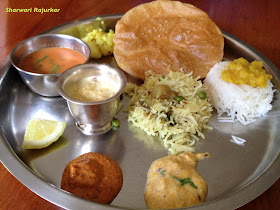Matar Karanji
Whether you are hosting a party or
attending one, why do only the most delicious snacks never seem enough to go
around? Is it because they are tastier when made in smaller quantities when the
maker can pay better attention to the quality and taste factor? Or is it that
they are walloped by all and therefore disappear faster?
Whatever it is, it’s the sorriest sight to
see hosts and organisers running around helter skelter when the cry of “We’re
out of samosas, pooris, or rice, or gulaab jamuns!” goes out…
The guests also join in in the melee, not
really to be of help, but to help themselves and stock (hoard?) whatever they
can lay their hands on onto their plates!
One cardinal rule of entertaining,
ingrained on my mind by a great and enthusiastic cook of a mother and a husband
who is generous to a fault, is that food should be offered in sumptuous,
“bharpoor” quantities. It’s all right even if you cook way more than is
consumed, but the food should not run short. Even if it means we eat the left
overs for a few days or even weeks depending on if the food can be frozen.
A more graceful option in this part of the
world where you generally don’t have live in domestic help to clear and wash up
and to share the spoils (pun intended), is to have all the guests happy to take
home a box of something they have liked.
So in that short window between finishing
dinner and serving dessert, some furious activity that resembles a fishpond at
feeding time takes place. The take-away plastic containers come out, guests
pick and choose what they want and boxes are packed and stacked in plastic
carry bags with labels or markers!
But then the main question doesn’t get
answered. How much should one cook?
Is it OK to fall just a little short and wait
and watch everyone even out and adjust within the spread laid out?
Or is it better to prepare more by way of
abundant caution and then worry as to how to dispose of it?
Or is it smarter to make it just a little
short, so everyone tantalised remembers how they loved your dish, but could
have done with a little more?
I have experienced this with the matar
karanjis prepared by some students one Diwali over 9 years ago. These
delectable calzones were decimated in minutes by piranhaesque guests at the
party!
I remembered their taste as if it was just
yesterday - and recreated the magic recently at a dinner I hosted.
I ended up making enough and more and
packing some for the guests!!
Matar Karanji
For the pastry
1 cup plain flour
½ cup semolina
2 tbsp oil for shortening
Salt to taste
For the filling
1 cup frozen peas
1 small potato, boiled and mashed
1 small onion, finely chopped
1 tsp (or more) finely chopped green chilly
1 tsp garlic and ginger paste
1 tbsp chopped coriander
1 tbsp grated fresh coconut
Dry mango powder (amchur) to taste
1 tsp garam masala
1 tsp cumin-coriander powder
½ tsp haldi powder
1 tbsp chopped cashews
Salt to taste
1 tbsp oil
Oil to fry
Making the pastry
Mix the ingredients for the pastry into a
smooth and firm dough. Keep covered for 30 minutes. Just before making it, give
it a good knead- I use the age old technique of pounding it with a pestle or
rolling pin! Make into equal sized balls and keep aisde.
Making the matar stuffing
Heat oil in pan and add the onion,
garlic-ginger paste and chillies and sauté the mixture. Add the haldi powder
and the green peas. Mash the peas while sautéing them. Now add all the spices
and the coriander. Add the mashed potato and salt to taste and mix well. Remove
from the heat and allow to cool.
Making the karanjis
Roll out the balls of dough into pooris and
place a tablespoon of the matar mixture on it. Fold the poori to form a
gujiya/karanji/calzone shape. Press the sides together and make impressions on
the edge with a fork to crimp the sides. Make sure the stuffing sufficiently
fills out karanji. Prepare all karanjis and fry them in medium hot oil until
golden brown.
Serve with a chutney or sauce. I served it
with a green tomato chutney.
My blogger and Facebook friend Suranga Date writes poems inspired by various sights and thoughts she comes across during the course of the day in her blog Strewn Ashes. She often writes delightful and insightful poems in Marathi and English based on my posts (and those of other bloggers)! She has written this lovely poem titled The yin, the yang and the yum based on this recipe! Enjoy!








